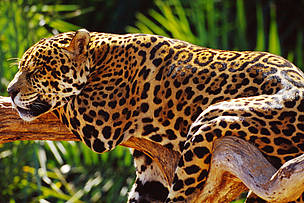Jaguar, cougar, and ocelot: In its last episode, the series “Residents of the Forest” brings images of the large Amazon felids
agosto, 15 2019
Animals are at high risk of extinction, according to the Red Book of Brazilian Fauna.
By Jorge Eduardo DantasIn its ninth and final episode, the web series “Residents of the Forest”, produced by WWF-Brasil since last year, brings another set of unpublished and exclusive images. This time, the stars are the big cats of the Amazon. Among the animals depicted in the video are jaguarundis (also known as the "gato-mourisco" or "moorish" cat in Portuguese), ocelots, cougars (also known as pumas), and jaguars.
Recorded during the last few months at the Chico Mendes Extractive Reserve (Resex) in the state of Acre, Brazil, the images were captured through tree-mounted camera traps that have motion sensors and record anything that moves. By doing so, these cameras could record scenes of animals in their natural environments during the day and night.
Watch the video:
Emblematic species
The Amazonian felids belong to the Felidae family and emerged approximately 25 million years ago. Short-haired and with paws adapted for running, they also have very developed senses – notably sight, smell, and hearing. As skilled hunters, they run at high speeds and jump with exceptional strength and precision. Therefore, they are usually predators of the environments in which they live.
This predation is very important, as these big cats help maintain the ecological balance of their areas. Thus, animals such as white-lipped peccaries, collared peccaries, and deers have their populations controlled in certain environments thanks to the presence of big cats.
Cats need large areas of continuous forest to survive, and loss of habitats is a major threat to their survival. Notably, the reduction of protected areas directly threaten felids, as well as agricultural expansion, poaching, mining, and the construction of hydropower dams.
Additionally, roadkill is another serious problem. Studies from the Brazilian Center for Road Ecology Studies, from the Federal University of Lavras (UFLA), in the state of Minas Gerais, show that more than 15 animals are run over on the Brazilian roads every second.
Diversity
Jaguars (Panthera onca), cougars (Puma concolor) and ocelots (Leopardus pardalis) are the largest felids in Brazil. In fact, the jaguar is the largest felid in the Americas, reaching about 1.80 meters in length and weighing up to 270 pounds. Jaguars are animals of solitary habits and excellent predators, but they rarely attack human beings. Extremely agile, jaguars are also skillful swimmers. They have a powerful bite.
On its turn, the cougar can jump from a distance of up to six meters and heights of over 15 meters. An animal of nocturnal habits, the cougar is hard to spot and feeds on small rodents to large mammals.
As for ocelots, they reach 77 centimeters and 48 pounds. Ocelots are versatile animals, adapting to various environments, and are abundant in Brazil – occur in more than 80% of the areas studied in the country. Ocelots usually hunt at night, spending the day in hiding, and are much targeted by hunters because of the beauty of their skin.
Finally, the jaguarundi (Puma yagouaroundi) has a very distinctive look, with a slender and elongated body. Jaguarundis have small and flatheads, short and round ears, short legs, and very long tails. Ranging from black or dark brown to reddish, they are the only unspotted small cats and can be often seen high in the trees.
Protecting and defending
Sadly, big cats face serious problems and are under threat. According to the Red Book of Endangered Brazilian Fauna, jaguars, cougars, and jaguarundis are classified as “vulnerable” species – meaning that they are at high risk of extinction in the wild.
According to WWF-Brazil conservation analyst Felipe Spina, big cats are among the most endangered Amazonian animals. “This is why such a video series is so important. They show the abundance inside our forests and one that can be lost if we don't take the necessary care. This is why is necessary to defend and reinforce the existing work in our protected areas and preserve vast areas of continuous forest,” said the biologist.
A recent survey by WWF-Brazil showed that the 316 federal and state protected areas in the Amazon are threatened: infrastructure projects, mining and power generation projects, as well as deforestation and growth of private areas around these units, weaken and leave the protected areas even more vulnerable.
Monitoring
The video series entitled “Residents of the Forest” aims to bring to the public unpublished and exclusive images of the Amazon fauna that live within the Chico Mendes Extractive Reserve. Eight episodes have been previously released, depicting animals such as tapirs, anteaters, birds, monkeys, canids, and armadillos.
These images are part of a wildlife monitoring work that takes place in that Resex. Moreover, it seeks to find out if the wood forest management carried out within the reserve affects the animals that live there.











